#Australidelphia
Explore tagged Tumblr posts
Text

A whole collection of Oceania marsupials! There are so many of these little creatures.
#australidelphia#bandicoot#tasmanian devil#thylacine#quoll#numbat#bilby#animals#species sketchpage#my art
50 notes
·
View notes
Text
It's #NationalAardvarkWeek! Besides being one of my favorite mammals, it's also the most evolutionarily distinct one (more on that below). Stay tuned for more aardvark art and info all week long! 😎 #AardvarksAareAawesome
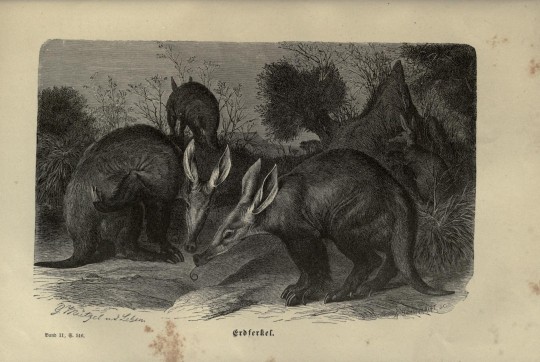
"Erdferkel," Plate 14 in Brehms thierleben, allgemeine kunde des thierreichs, 1876-9. Biodiversity Heritage Library.
#DYK the Aardvark (Orycteropus afer) is the only living representative of an entire ORDER of mammals, Tubulidentata? This helped it score as the #1 most evolutionarily distinctive (ED) mammal on ZSL's EDGE of Existence list:
[FYI the only other mammal order with a single living member is Microbiotheria, represented by the Monito del Monte (Dromiciops gliroides) - however they have more living relatives one step out in superorder Australidelphia than the Aardvark does in the Afrotheria.]
#aardvark#mammals#mammalogy#zoology#Tubulidentata#Microbiotheria#Monito del Monte#Australidelphia#Afrotheria#ZSL#EDGE of Existence#evolutionarily distinctive#illustration#book illustration#European art#German art#19th century art#lithograph#print#National Aardvark Week#Aardvarks Aare Aawesome#animals in art
4 notes
·
View notes
Text
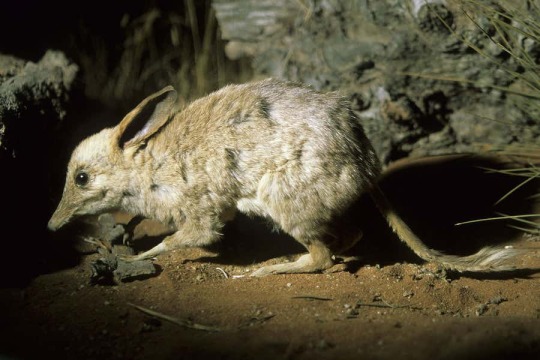
Chaeropus ecaudatus the Southern Pig–footed Bandicoot
Pig–footed bandicoots (genus Chaeropus) were so called because of their hooflike forefeet. They had relatively slender legs compared to other bandicoots, allowing them to move quickly through the landscape.
Although initially designated as a single species, Chaeropus yirratji was split from C. ecaudatus in 2019 on the basis of morphological differences. Both species became extinct by the 1950s due to habitat loss from land clearing for agriculture and predation from cats and foxes.
#southern pig–footed bandicoot#animals#australian animals#mammals#australian mammals#marsupials#australian marsupials#bandicoots#pig–footed bandicoot#s o: australidelphia#o: peramelemorphia#f: chaeropidae#g: chaeropus#sp: c. ecaudatus
32 notes
·
View notes
Text
There's also a genus of marsupial called Antechinus where the males have so much sex they die of exhaustion after
They look like this

too many people see evolution as just animals becoming better animals when the truth is that theres a species of boar that evolved to die because its tusks grow into its skull because the males with long tusks fuck the most
#evolution#evolutionary biology#antechinus#animals#mammals#marsupials#s o: australidelphia#o: dasyuromorphia#f: dasyuridae#s f: dasyurinae#tr: phascogalini#g: antechinus
160K notes
·
View notes
Text
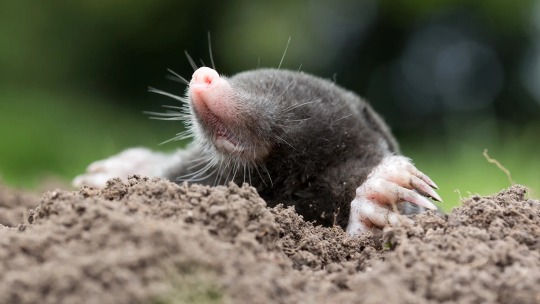
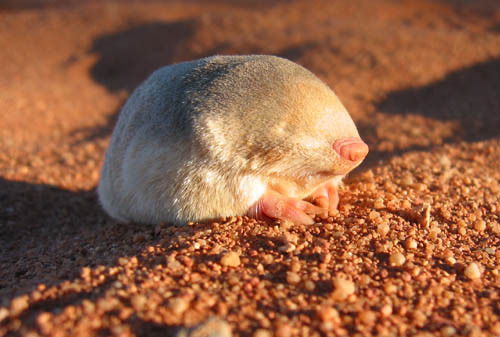
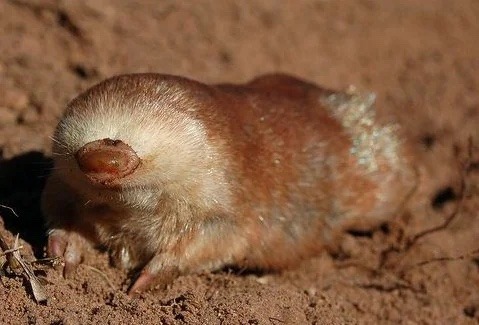
@sabertoothwalrus Now that people are interested in moles. These three moles are not related.
Top one is Laurasiatheria (same superorder as dogs, horses, bats, and hedgehogs)
Middle one is Afrotheria (same superorder as elephants, tenrecs, aardvarks, and manatees)
And the bottom one is Australidelphia (same superorder as cuscuses, quolls, bandicoots, and wallabies)
All three have convergently evolved to be moles! How cool is that!
3K notes
·
View notes
Photo
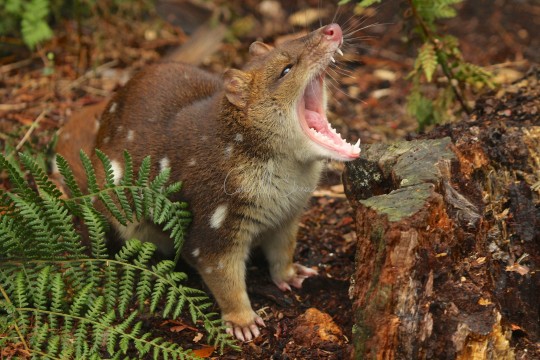
Spotted-tail quoll (Dasyurus maculatus)
Photo by Caleb McElrea
#spotted tail quoll#tiger quoll#quoll#dasyurus maculatus#dasyurus#dasyurini#dasyurinae#dasyuridae#dasyuromorphia#australidelphia#marsupialia#metatheria#mammalia#tetrapoda#vertebrata#chordata
859 notes
·
View notes
Text
†Pig-footed Bandicoots (Chaeropus)
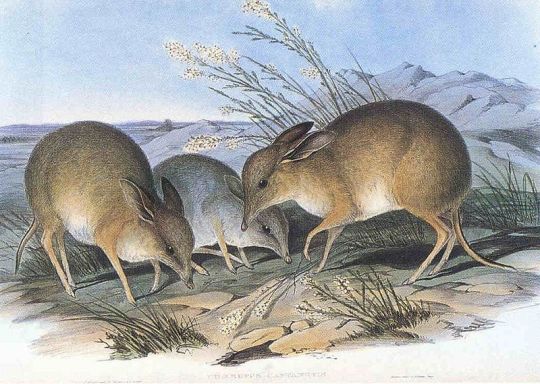
Pig-footed bandicoots were recently considered separate to all other bandicoots. Two similar species are recognized, varying in historical ranges and morphology of dentition and feet. Their fur ranged from uniform grey-brown to russet and fawn tones, helping them camouflage into arid sandy desert and grassland. From 32 to 40cms long, they measured up similarly to a small rabbit.
Chaeropus, uniquely, had feet like tiny hooves. They walked on only two functional toes of the forefeet, and one toe of the hind-foot, the rest being vestigial. They were known to run very fast, with a quick bounding gait. Though reported to eat insects, it’s thought they were largely herbivorous.
The Southern pig-footed bandicoot, C. ecaudatus, occurred through desert shrub-lands in the lower part of South Australia extending into Western Australia. C. yirratji, the Northern pig-footed bandicoot, inhabited grassland and sandy desert in central Australia and WA.
Both species were never prolific according to Indigenous oral tradition. However, they were in serious decline by the 19th century and were extinct less than 150 years after European description. Foxes were not yet established in their ranges, and though some cats were, the cessation of thousands of years traditional burning practices is thought to have been the major contributor to their extinction. Burning provided a patchwork of new growth on which to feed alongside recovered zones of shelter. Introduction of sheep and cattle also changed the landscape dramatically, further decimating crucial food sources of native animals.
#Chaeropus#pig-footed bandicoot#Chaeropodidae#Southern pig-footed bandicoot#Northern pig-footed bandicoot#Chaeropus ecaudatus#Chaeropus yirratji#Peramelemorphia#marsupials#australian animals#australian wildlife#Australidelphia#extinction
57 notes
·
View notes
Text
This is great news! 😄
they should make shopping for cables easier i think. there should be a service where you pick the ends, you pick the length of cable, you pick the like. color and texture of the cable (shitty plastic, nicely woven, bare metal, whatever) and then they make it and ship it to you for a reasonable fee
#western quoll#animals#mammals#marsupials#quolls#s o: australidelphia#o: dasyuromorphia#f: dasyuridae#s f: dasyurinae#tr: dasyurini#g: dasyurus#sp: d. geoffroii#conservation
35K notes
·
View notes
Text
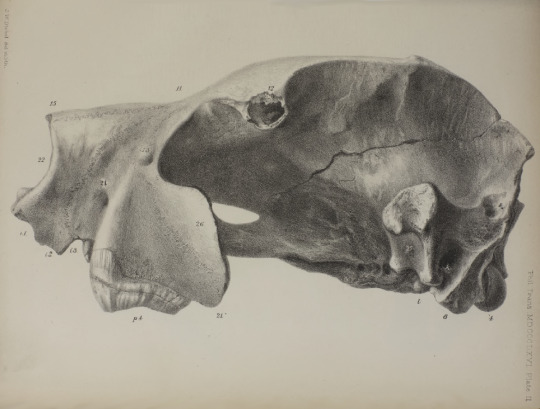
Side view of skull of Thylacoleo carnifex. From On the fossil mammals of Australia. - Part II. Description of an almost entire skull of the Thylacoleo carnifex, Owen, from a freshwater deposit, Darling Downs, Queensland
#thylacoleo carnifex#animals#mammals#marsupials#thylacoleo#s o: australidelphia#o: diprotodontia#s o: vombatiformes#f: thylacoleonidae#g: thylacoleo#sp: t. carnifex#palaeontology
31 notes
·
View notes
Text
So there’s possums and opossums right? Opossums are from the Americas, members of Ameridelphia which includes every marsupial in America, and possums are from Australia (and some surrounding area) and members of Australidelphia, which includes every marsupial in Australia.
So American Opposums look like this

And then somebody named this thing a possum because it looks like the American one:

I mean it doesn’t, but ok, it has a pouch, it has opposable thumbs, close enough. Even though opossum comes from a Proto-Algonqian word meaning “white dog or dog-like beast” and this thing is like...sort of yellow? Whatever, not the point of this post.
The point of the post is this thing

This thing is a Colocolo Opossum. It lives in Argentina and Chile, and it was named that because it looks like the eastern pygmy possum from Australia. So it lives in America, but was named for the Australian possum, but it was named Opossum, which are the American ones?
Oh yeah, it also has a pouch, and opposable thumbs, and is a marsupial, so it’s related to...which one? Well it lives in America, it’s named Opossum, it’s clearly part of Ameridelphia right? Related to the other American Opossums? Nope. It’s closer to the Australian ones, it’s part of Australidelphia.
In fact, it’s the only marsupial in America that is not part of Ameridelphia, and the only marsupial that’s part of Australidelphia not native to Australia.
Now you might notice a problem here if you know about planet earth, and that’s that Australia and South America are pretty far from each other. Like over 10,000 kilometers? So how did this little guy cross the pacific?

So this is Cenozoic earth, the period we’re interested in is about 55 million years ago, when the first marsupial emerges. South America and Australia are connected by land via Antarctica. The thought was that maybe this guy walked from Australia to South America sometime 48 million years ago.
In 2010 they found out....they didn’t. They did some analysis of their DNA and found out that, yes, it is part of Australidelphia. It is also the most basal of that superorder though. It didn’t come to South America from Australia...every other Australian Marsupial came to Australia from South America, and they left this little dude behind.

So up there at the top is the American opossums, towards the bottom is all the Australian marsupials, our little friend here is the only one left in the order Microbiotheres.
This little guy is...sort of the bridge between American Opossums and Australian Possums.

4 notes
·
View notes
Text
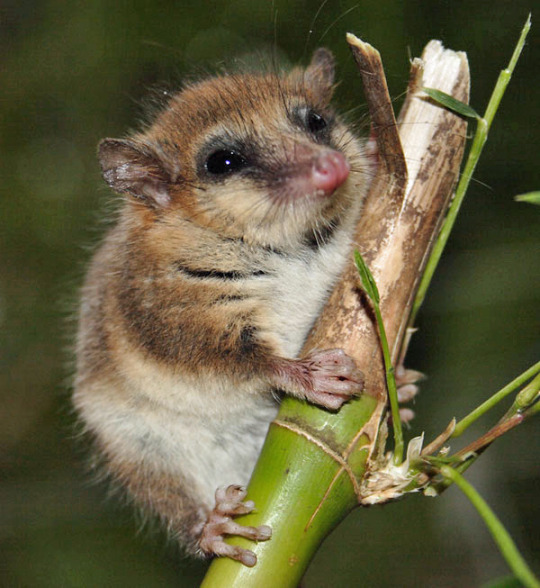
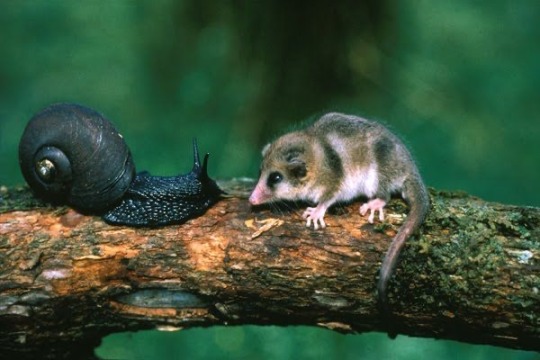
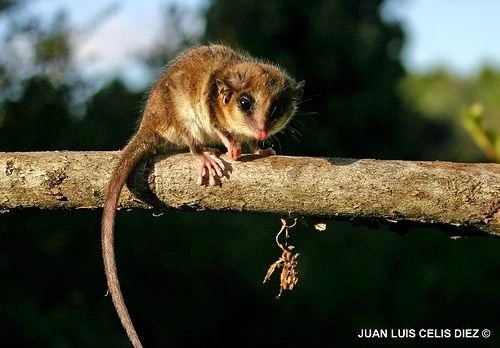
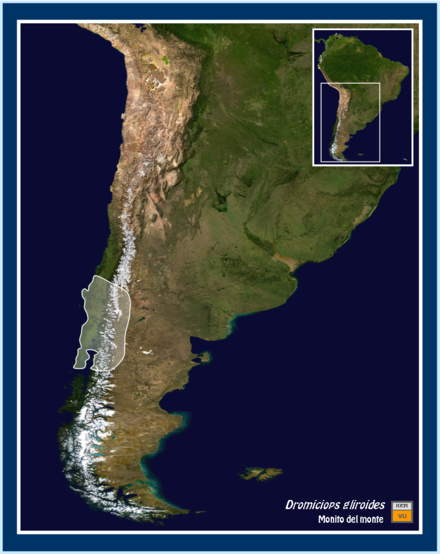
Monito del monte
Dromiciops gliroides
Family microbiotheriidae (only monito del monte still extant), order microbiotheria (only monito del monte still extant), superorder australidelphia (around 3/4 of marsupials. The Australian ones. From the Americas, only monito del monte still extant)
Very recently either one or two more species in its genus have been discovered. I’m gonna focus on this guy though.
Monito del monte is what a lot of people call a living fossil. This term is stupid though as it gives creationists hope that evolution is a hoax. “Living fossils” still evolve over time, just slower and in less noticeable ways.
The lineage of monito del monte is the most basal of the australidelphian superorder. The other two most basal marsupial groups to all of marsupials, not just australidelphians are the two opossum orders. That’s right! Two of em! Didelphimorphia (probably the first to branch), and paucituberculata.
So monito del monte was thought for the longest time to be a type of opossum, but they’re not opossums at all! Any physical similarities is convergent evolution baybee!
These guys live in spherical nests up in trees. They make the nests out of water resistant colihue leaves lines with moss or grass for insulation and camouflage (Colihue is a type of frost tolerant bamboo). They either live in pairs during the breeding season or year round. Not sure.
They also hibernate during winter! The base of the tail will swell with fat beforehand and their hearts slow from 230 bpm to under 30 bpm.
They mostly eat small invertebrates, but they like fruit. Especially mistletoe fruit.
ONLY NON OPOSSUM MARSUPIAL IN THE AMERICAS!!!!
@jackalspine @fifiibibii
11 notes
·
View notes
Note
You're not wrong

Pictured: a mounted skeleton of Thylacoleo carnifex, an extinct carnivorous marsupial.
Its closest living relatives are actually koalas (and wombats), and they were hypercarnivores that were quite capable climbers. They may have ambushed prey in a similar way to modern leopards, climbing and waiting in trees before dropping down to attack.
Whats a drop bear?
Carnivorous cousins of the Koalas that drop out of eucalyptus trees to attack tourists who go into the bush alone.
#palaeontology#thylacoleo carnifex#animals#mammals#marsupials#s o: australidelphia#o: diprotodontia#s o: vombatiformes#f: thylacoleonidae#g: thylacoleo#sp: t. carnifex
78 notes
·
View notes
Text
That's right, kangaroos are left-handed
By Will Dunham WASHINGTON (Reuters) - Research on wild kangaroos in Australia is challenging the notion that having a strong hand preference is a trait that developed primarily in people and other primates. Scientists said on Thursday that these Australian marsupials displayed a natural preference for using their left hand for feeding, self-grooming and other activities. "We found a pronounced degree of 'handedness,' comparable to that in our species," said biologist Yegor Malashichev of Saint Petersburg State University in Russia. http://dlvr.it/BGyMNz
0 notes
Text
Not to be pedantic but 'bilby' usually refers just to animals in the genus Macrotis. They're in the order Peramelemorphia, but the family Thylacomyidae. The bandicoots in your article are 'barred' or 'long-nosed' bandicoots in the genus Perameles, which is in a separate family Peramelidae. This is also in the order Peramelemorphia but highly distinct from Thylacomyidae.
There's also very likely a subspecies of Quenda in southwest South Australia which is pretty cool!
Multiple new cryptic species of bilby, and a case of mistaken identity among bandicoots leading to an accidental introduction:
Even after the catastrophic debacle of introducing non-native cane toads, European rabbits, foxes, dromedary camels, feral cats, and invasive invertebrates, Australian settler institutions are cursed with mistakes which unleash invasive animals even when attempting the well-meaning reintroduction of native species.
Some new research from 2018 revealed an alarming mistake in ecological management. Basically, you’ve got this cute little bilby from the remote far western coast near Shark Bay which was transported by scientists thousands of kilometers and now has a big strong population just chilling near Adelaide. Bilbies, or bandicoots, are understood to be important to maintaining healthy soils, especially in Mediterranean chaparral zone and the other climatically mild and temperate regions of the coast of southern Australia (ranging between Perth through Adelaide to the Melbourne area, and including Tasmania), so there is popular celebration of the reintroduction of bandicoots to environments which they historically inhabited before European agriculture and invasive species led to local extinction of many bandicoots. The western barred bandicoot (Perameles bougainville) went extinct across almost all of its range and disappeared from native habitats on the mainland after European invasion, but a few populations survived on extremely remote islands off the coast of Shark Bay in on the far western coast of Western Australia. Intending to help rehabilitate native soils and plant communities, Australian settler ecologists then took some bandicoots from Shark Bay islands and “reintroduced” the western barred bandicoot over 3000 kilometers away at the Arid Recovery Reserve, near Lake Torrens area north of Adelaide. This was done because settler scientists thought that this bandicoot species had historically lived across much of southern Australia. Uh oh: It turns out that this western barred bandicoot lineage was historically only native to a small portion of the western coast of Australia near Shark Bay far, far away and was never native to the Adelaide or Lake Torrens area, because what was assumed to be the “western barred bandicoot” was actually 5 different cryptic species. 4 of these species are now extinct. The only living member of this bandicoot lineage remains only at Shark Bay. But now, these Shark Bay bandicoots are living north of Adelaide, where a couple thousand of them live at Arid Recovery Reserve.
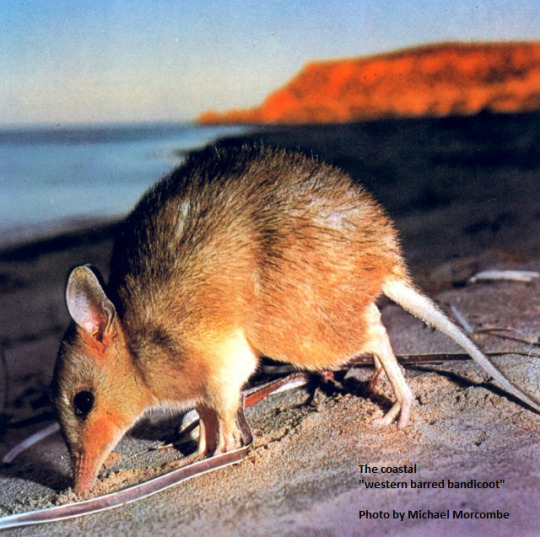
A western barred bandicoot from the coastal Western Australia population at the islands of Bernier and Dorre:
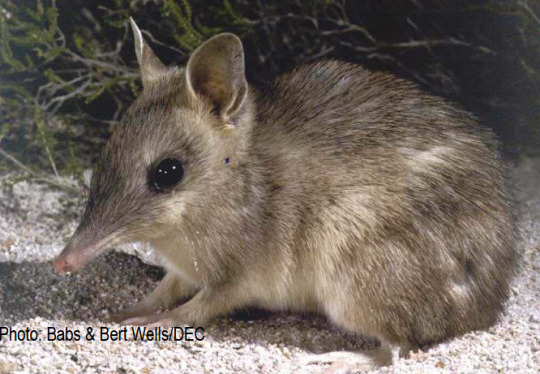
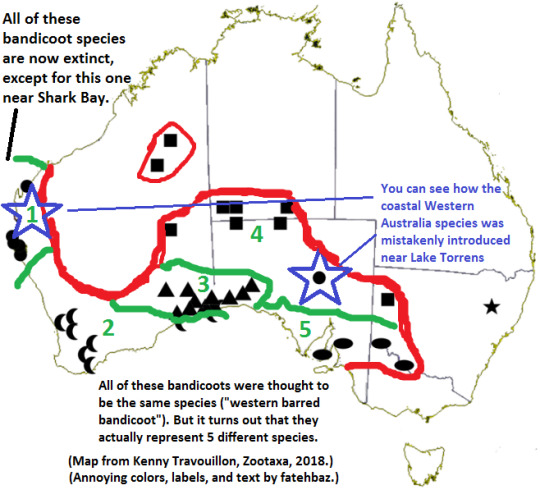
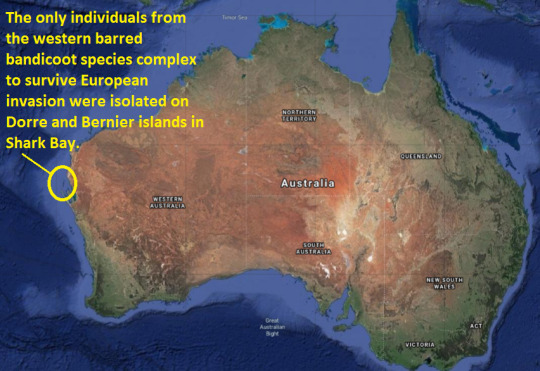
Kenny Travouillon, the lead researcher who reported the cryptic species and new understanding of bandicoot biodiversity, was featured recently in this report from Western Australian Museum, February 2018:
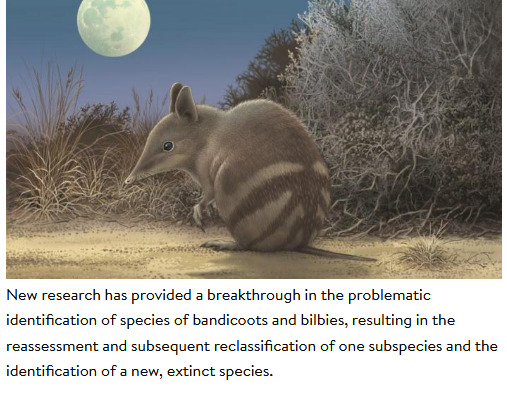
“For example, many people will have seen the Quenda (Isoodon obesulus fusciventer), a bandicoot familiar to Perth backyards. For more than 150 years the Quenda had been thought to be a subspecies of the Southern Brown Bandicoot (Isoodon obesulus) from the east coast of Australia, when in fact our research shows that it is a distinct species and more closely related to the Golden Bandicoot (Isoodon auratus) endemic to WA and found on Barrow Island and throughout the Kimberley.”
“We also re-evaluated the Western Barred Bandicoot (Perameles bougainville), a species now only found on islands near Shark Bay, and we found that it is in fact a complex of five distinct species. Four of these species had been named in the 1800s, but we described a new species from the Nullarbor region, the Butterfly Bandicoot or Nullarbor Barred Bandicoot (Perameles papillon). This is a new species that went extinct between 1920 and 1960, as a result of feral carnivores spreading west,” he said.
Four of the eight bandicoots that once lived in in WA are now extinct: the Pig-footed Bandicoot (Chaeropus ecaudatus), the Desert Bandicoot (Perameles eremiana), the Marl Bandicoot (Perameles myosuros) and the Butterfly Bandicoot (Perameles papillon). The four that remain are the Quenda (Isoodon fusciventer, previously known as the Southern Brown Bandicoot), Northern Brown Bandicoot (Isoodon macrourus), Golden Bandicoot (Isoodon auratus), and the Little Marl (Perameles bougainville), which was previously known as the Western Barred Bandicoot. [End of excerpt.]
Here’s a story on how the confusion has resulted in a non-native bandicoot species being reintroduced where it didn’t belong:

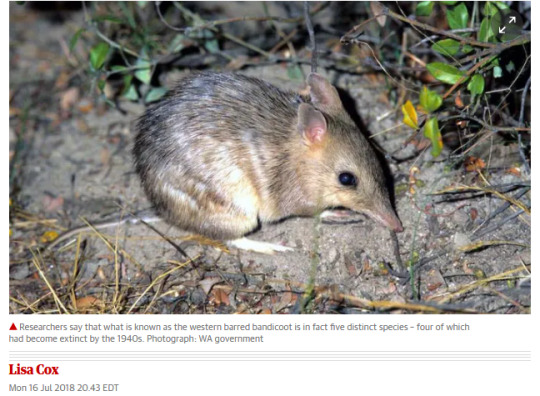
An endangered Australian bandicoot that was reintroduced to the Australian mainland is now believed to be one of five distinct species, and researchers say it may have been a mistake to introduce it to South Australia.
Scientists working for the Western Australian Museum have published research that concludes that what has been known as the western barred bandicoot is in fact five distinct species – four of which had become extinct by the 1940s as a result of agriculture and introduced predators. The species were closely related but occurred in different parts of Australia.
In the 2000s, western barred bandicoots that had survived on the arid Bernier and Dorre islands off Western Australia were reintroduced to the mainland, including to a predator-proof reserve in outback South Australia. But the new study shows the surviving species that was translocated to that part of the country would never have occurred there previously. Lead researcher Dr Kenny Travouillon made the findings after analysing skulls and DNA from tissue from specimens held in collections in Paris and London.He said the research, which was published in Zootaxa, came to the conclusion that the western barred bandicoot was the only remaining species of the five.
The species that has been reintroduced around Australia would have originally occurred only in parts of Western Australia. “On the mainland, that species should have only been in WA along the coast from Shark Bay to Onslow,” he said. “They should never have been brought to South Australia, but that decision was made from the old research.” Dr Kath Tuft, the general manager of the Arid Recovery Reserve in South Australia, said there were now as many as 2,000 western barred bandicoots at the reserve. She said what had been considered a reintroduction of the species was now technically an introduction. [End of excerpt.]
—–
Important distinction: There is another celebrated - and more successful - bandicoot reintroduction project involving a different species.
The eastern barred bandicoot (Perameles gunnii) lives on Tasmania and on the mainland in southern Victoria near Melbourne. The population that once inhabited mainland ecosystems almost went entirely extinct, but there are multiple successful reintroduction sites in Victoria and a captive breeding program.
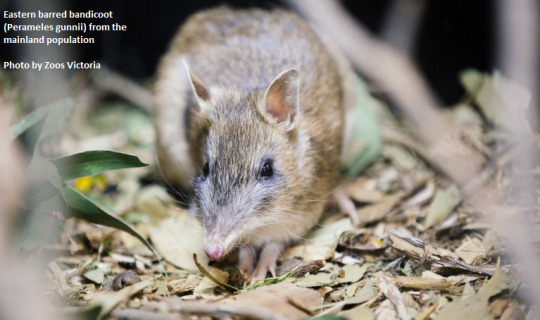
The species also lives on Tasmania, but here are the reintroduction sites on the mainland near Melbourne [map from the species recovery plan, State Government Victoria]:
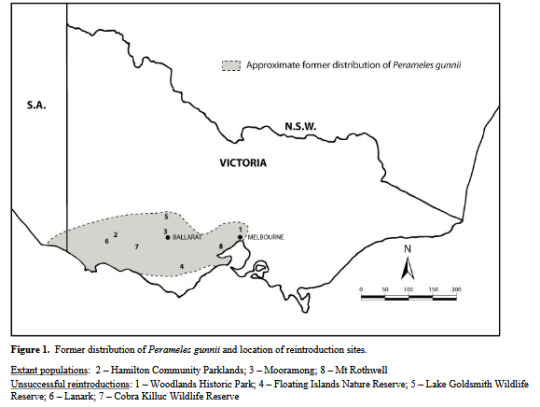
This bandicoot species does belong in mainland southern Australia.
11 notes
·
View notes
Text

Kowari (Dasyuroides byrnei)
Photo by charliejb
#captive animal#kowari#dasyuroides byrnei#dasyuroides#dasyurini#dasyurinae#dasyuridae#dasyuromorphia#australidelphia#marsupialia#metatheria#mammalia#tetrapoda#vertebrata#chordata
169 notes
·
View notes
Text

I’m hoping to continue working on my species project throughout the new year! I excluded the order diprotodontia from this particular set to save space, look forward to those sketches soon.
3 notes
·
View notes